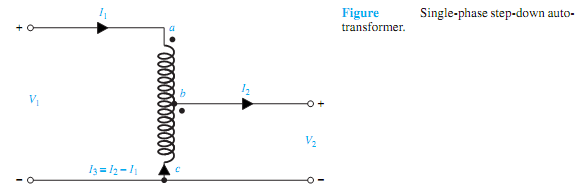Q. What is Autotransformers?
In contrast to a two-winding transformer, the autotransformer is a single-winding transformer having a tap brought out at an intermediate point. Thus, as shown in Figure a-c is the single N1-turn winding wound on a laminated core, and b is the intermediate point where the tap is brought out such that b-c has N2 turns. The autotransformer may generally be used as either a step-up or a step-down operation. Considering the step-down arrangement, as shown in Figure, let the primary applied voltage be V1, resulting in amagnetizing current and a core flux φm. Voltage drops in the windings, exciting current, and small phase-angular differences are usually neglected for the analysis. Then it follows that

in which a> 1 for step-down, a< 1 for step-up transformers.
The input apparent power is S1 = V1I1, while the output apparent power is given by S2 = V2I2. The apparent power transformed by electromagnetic induction (or transformer action) is Sind = V2I3 = (V1-V2)I2. The output transferred by electrical conduction (because of the direct electrical connection between primary and secondarywindings) is given by Scond = V2I2-V2I3 = V2I1.

For the same output the autotransformer is smaller in size, weighing much less than a two- winding transformer, and has higher efficiency. An important disadvantage of the autotransformer is the direct copper connection (i.e., no electrical isolation) between the high- and low-voltage sides. A type of autotransformer commonly found in laboratories is the variable-ratio autotransformer, in which the tapped point b is movable. It is known as the variac (variable ac). Although here, for the sake of simplicity, we have considered only the single-phase autotransformer, three-phase autotransformers, which are available in practice, can be modeled on a per-phase basis and also analyzed just as the single-phase case.